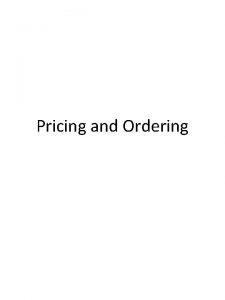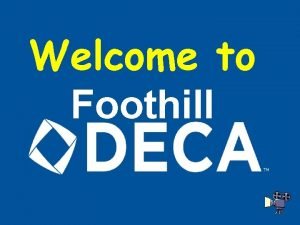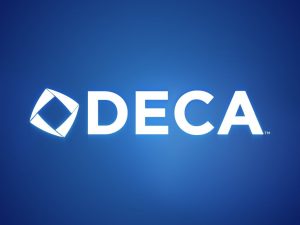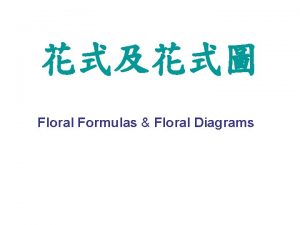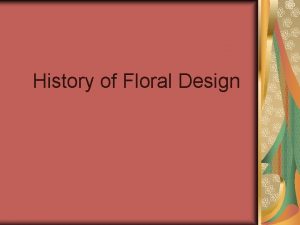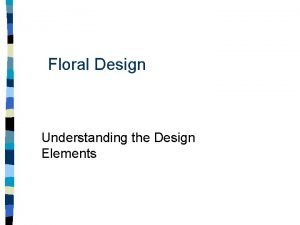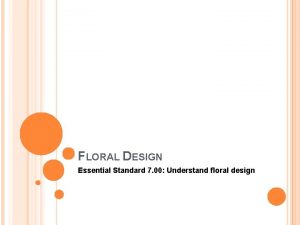n Understanding the Floral Design Elements Next Generation






























- Slides: 30

n Understanding the Floral Design Elements

Next Generation Science/Common Core Standards Addressed! n CCSS. ELA Literacy. RH. 11‐ 12. 2 Determine the central ideas or information of a primary or secondary source; provide an accurate summary that makes clear the relationships among the key details and ideas. n CCSS. ELA Literacy. RST. 11‐ 12. 2 Determine the central ideas or conclusions of a text; summarize complex concepts, processes, or information presented in a text by paraphrasing them in simpler but still accurate terms. n CCSS. ELA Literacy. RS T. 11‐ 12. 4 Determine the meaning of symbols, key terms, and other domain‐specific words and phrases as they are used in a specific scientific or technical context relevant to grades 11– 12 texts and topics.

Agriculture, Food, and Natural Resource Standards Addressed n PS. 04. 02. Create designs using plants. . PS. 04. 02. 01. b. Apply principles and elements of design that form the basis of artistic impression.

Bell Work / Student Objectives! n n 1. List and describe the major forms (or shapes) used in floral design. 2. Explain how space and depth enhance floral design. 3. Describe the importance of texture in floral design. 4. Explain how color influences floral work.

Vocabulary n n n n n Advancing color Analogous Color wheel Complimentary Depth Design elements Filler flowers Form flowers n n n n n Free form Geometric Line materials Mass flowers Monochromatic Naturalistic Polychromatic Primary colors

Vocabulary Cont. n n n Receding colors Secondary colors Shape Space Tertiary colors Texture

Interest Approach Take a look at the examples of floral designs on your handout. Compare and contrast these arrangements with your neighbor. Look at the shape, color, texture and size. Try to visualize the same arrangements in a different color or size. Would the arrangements have the same visual effect? Why or why not?

What Are the Major Forms or Shapes Used in Floral Design? n n n Floral arrangements are composed of flowers, greenery and containers. The physical characteristics that the designer uses to create the arrangements are called design elements. Form and shape are the first two design elements.

n n n Form refers to the 3 -dimensional outline of the arrangement. Shape is the 2 -dimensional term form. The common forms used in floral design are: geometric, naturalistic and free form. . Geometric shapes are most often circles or triangles. u Can be varied into ovals, fans, crescents, right triangles, isosceles triangles and asymmetrical triangles. . Naturalistic designs - mirror the natural plant growth; Include groupings of plant material, using branches to symbolize trees and shorter flowers the undergrowth.

. n n Free form arrangements are more contemporary; Very creative and do not have any particular design rules. All forms of arrangement are created through the use of lines. Line is the visual movement between two points in an arrangement. Placement creates shape and expresses emotions. . Can be created through the use of line material. . n Line materials (like snapdragon, liatris and scotch broom) are used to create definite vertical, horizontal, diagonal or curvilinear lines.

Free Form Design!



Design Forms

n The remainder of the arrangement is created through the combination of form, mass and filler flowers. . Form flowers are those with distinctive shapes. u Ex. . Mass flowers are round, solid flowers. u Ex. . Orchids, lilies Mums, carnations, roses Filler flowers are light, airy flowers that fill in the space between other flowers. u Ex. Baby’s breath, sea foam statice

How Do Space and Depth Enhance Floral Design? n The areas in the design that have no flowers are just as important as the flowers themselves. . n Areas devoid of flowers are called space. It is important for designers to leave space in their arrangements. . Space increases the apparent size of a design by adding space and depth to the design.

. Depth gives the arrangement more of a three dimensional form than just a shape. u Achieved by tucking flowers in further so they are partially hidden; and dangling flowers upward or to the side. . Space makes the arrangement appear to be larger even though no more materials are used; Occurs if the flowers are placed away from each other. u Helps to save money by creating a larger, more. expensive-looking design. u Adds more interest in the design.

Find the areas in these designs the enhance depth and space.

How Is Texture Important in Floral Design? n Floral designers can create visually attractive arrangements by combining plant material with different textures. . Texture is the design element that refers to the surface quality of the plant material. u Plant material can be rough, smooth, leathery, velvety, satiny or hairy. u It can also have visual texture - fine, airy, lacy, delicate, bold or coarse. . By varying textures in a design, it will attract attention and hold the viewer’s interest.

Explain how these designs have texture.

How Does Color Influence Floral Work? n Color is probably the most obvious design element. . n n An arrangement can lose its appeal if the colors are not striking. Color contributes to people’s feelings. They have also influenced occasions or events. . For example, red symbolizes love; Orange symbolizes Halloween; yellow symbolizes friendship.

Colors and Emotions/occasions

n The color wheel is made up of primary, secondary and tertiary colors. Primary = red, blue, yellow. Secondary = orange, green, violet. u Two . primary colors combined Tertiary = one primary combined with one secondary color u Names are always hyphenated z For example blue-green, orange-red n There are six color schemes that designers can use to create beautiful arrangements. Created by the combination of one or more colors

Color Schemes

Monochromatic Analogous Complimentary ex. Blue & orange Triadic

Polychromatic Split-Complimentary

n n No matter what color scheme is used, remember they are viewed differently depending on what colors they are combined with. Advancing colors move towards the viewer. . n For example yellow, red and orange Receding colors disappear into the background. For example violet, blue and green

Summary n n n List the twelve design forms. How is a geometric form different from a naturalistic one? Describe the difference between form, mass and filler flowers. Give an example of each. How can depth and space enhance a design? What is texture? Why should you vary the texture in an arrangement? Name three primary and secondary colors.

Summary Cont. n n n How do you create a tertiary color? Using the color wheel, give an example of each of the color schemes. What are advancing colors? Receding colors?

The End!
 X.next = x.next.next
X.next = x.next.next Floral pricing worksheet
Floral pricing worksheet Floral design elements
Floral design elements Stahl
Stahl Lord your mercy endureth forever
Lord your mercy endureth forever Next generation security platform
Next generation security platform Global next generation wireless communication market
Global next generation wireless communication market Ncsbn model of clinical judgement
Ncsbn model of clinical judgement Next generation soc
Next generation soc Next-generation smart contracts
Next-generation smart contracts Vaccine therapy
Vaccine therapy Next generation application management
Next generation application management Next generation learning platform
Next generation learning platform Palo alto networks next generation security platform
Palo alto networks next generation security platform What is next generation text service
What is next generation text service Nclex next generation
Nclex next generation Electrical energy
Electrical energy Next generation emr
Next generation emr Ip next generation
Ip next generation Next generation backup
Next generation backup Educating the next generation of leaders
Educating the next generation of leaders Yang bukan arsitektur fungsi softswitch adalah
Yang bukan arsitektur fungsi softswitch adalah Robson management corporation
Robson management corporation Nys next generation standards math
Nys next generation standards math Trojan uv swift sc manual
Trojan uv swift sc manual Next generation learning challenges
Next generation learning challenges Anil vasudeva
Anil vasudeva Foothill deca
Foothill deca Hp-hvof
Hp-hvof Deca prepares the next generation to be
Deca prepares the next generation to be Next generation sequencing methods
Next generation sequencing methods

